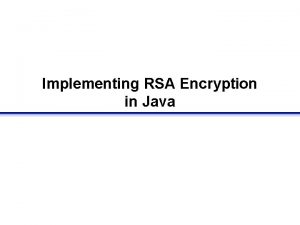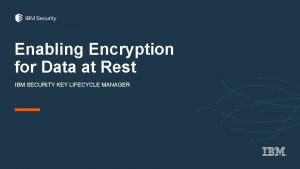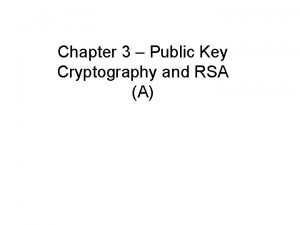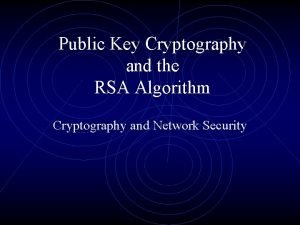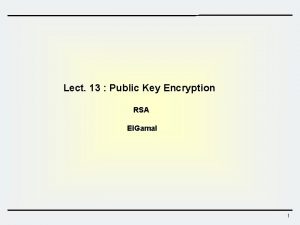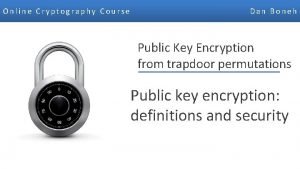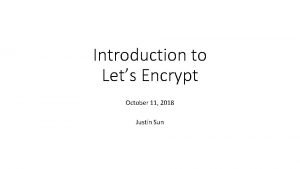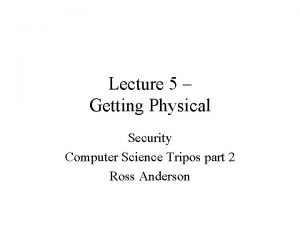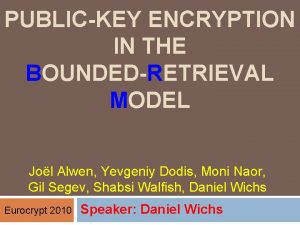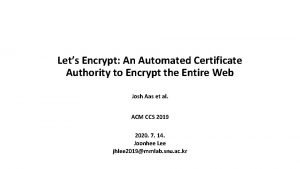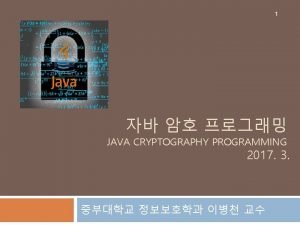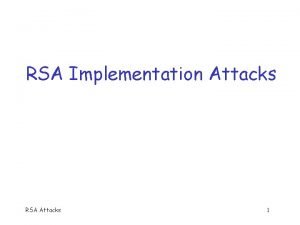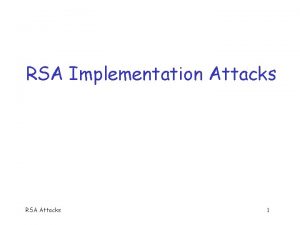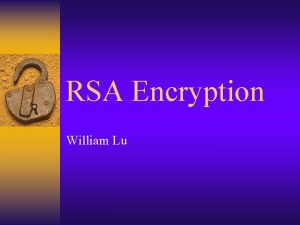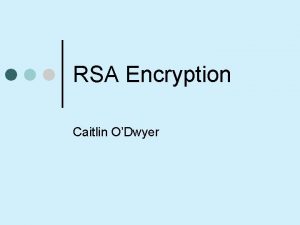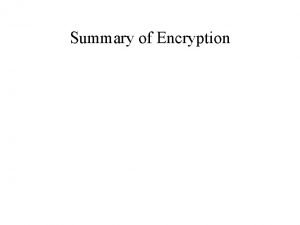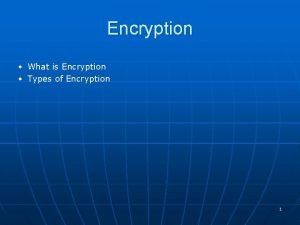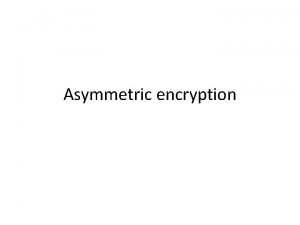Lecture 6 RSA Use in Encryption to encrypt














- Slides: 14

Lecture 6

RSA Use in Encryption • to encrypt a message M the sender: – obtains public key of recipient PU={e, n} – computes: C = Me mod n, where 0≤M<n • to decrypt the ciphertext C the owner: – uses their private key PR={d, n} – computes: M = Cd mod n • note that the message M must be smaller than the modulus n (block if needed)

RSA Example - En/Decryption • sample RSA encryption/decryption is: • given message M = 88 1. Publish public key PU={7, 187} 2. Keep secret private key PR={23, 187} • encryption: C = 887 mod 187 = 11 • decryption: M = 1123 mod 187 = 88

Assignments 1. Perform encryption and decryption using RSA algorithm, as in Figure 1, for the following: ① p = 3; q = 11, e = 7; M = 5 ② p = 5; q = 11, e = 3; M = 9 Encryption Plaintext 88 88 7 mod 187 = 11 Ciphertext 11 Decryption 11 23 mod 187 = 88 Plaintext 88 KU = 7, 187 KR = 23 , 187 Figure 1. Example of RSA Algorithm 2. In a public-key system using RSA, you intercept the ciphertext C = 10 sent to a user whose public key is e = 5, n = 35. What is the plaintext M?

Why RSA Works • because of Euler's Theorem: – aø(n)mod n = 1 where gcd(a, n)=1 • in RSA have: – – n=p. q ø(n)=(p-1)(q-1) carefully chose e & d to be inverses mod ø(n) hence e. d=1+k. ø(n) for some k • hence : Cd = Me. d = M 1+k. ø(n) = M 1. (Mø(n))k = M 1. (1)k = M 1 = M mod n

Efficient Encryption • Encryption uses exponentiation to power e • Hence if e small, this will be faster – often choose e=65537 (216 -1) – also see choices of e=3 or e=17 • But if e too small (eg e=3) can attack – using Chinese remainder theorem & 3 messages with different moduli

Efficient Decryption • Decryption uses exponentiation to power d – this is likely large, insecure if not • can use the Chinese Remainder Theorem (CRT) to compute mod p & q separately. then combine to get desired answer

Exponentiation • • can use the Square and Multiply Algorithm a fast, efficient algorithm for exponentiation concept is based on repeatedly squaring base and multiplying in the ones that are needed to compute the result • look at binary representation of exponent • only takes O(log 2 n) multiples for number n – eg. 75 = 74. 71 = 3. 7 = 10 mod 11 – eg. 3129 = 3128. 31 = 5. 3 = 4 mod 11

Exponentiation • The algorithm for computing ab mod n • The b integer is expressed as as binary number : bk , bk-1 , …, b 0

Example • Get 7 5 mod 11= ? ? ab mod n as in th algorithm 1 0 1 b 2 b 1 b 0 • So b= 5 101 k Ask? b(k) • n= 11 a= 7 • The final result is = 10 c 0 2 0 Yes b 2 = 1 1 1 d 1 1 7 2 5 No 0 4 3 5 10

Example • Get 10 3 mod 60= ? ? ab mod n as in th algorithm 1 1 b 0 • So b= 3 11 2 k Ask? b(k) • n= 60 a= 10 • The final result is = 40 c 0 1 0 Yes b 1 = 1 1 0 Yes b 0 = 1 d 1 1 10 2 40 3 40

RSA Security • three approaches to attacking RSA: – brute force key search (infeasible given size of numbers) – mathematical attacks (based on difficulty of computing ø(N), by factoring modulus N) – timing attacks (on running of decryption)

Factoring Problem • mathematical approach takes 3 forms: – factor N=p. q, hence find ø(N) and then d – determine ø(N) directly and find d – find d directly • currently believe all equivalent to factoring – have seen slow improvements over the years • as of Aug-99 best is 130 decimal digits (512) bit with GNFS – biggest improvement comes from improved algorithm • cf “Quadratic Sieve” to “Generalized Number Field Sieve” – barring dramatic breakthrough 1024+ bit RSA secure • ensure p, q of similar size and matching other constraints

Summary • have considered: – prime numbers – Fermat’s and Euler’s Theorems – Primality Testing – Chinese Remainder Theorem – Discrete Logarithms – principles of public-key cryptography – RSA algorithm, implementation, security
 Java rsa encryption example
Java rsa encryption example Ibm sklm
Ibm sklm Microsoft rsa encryption
Microsoft rsa encryption Rsa encryption history
Rsa encryption history Rsa encryption history
Rsa encryption history Rsa crittografia
Rsa crittografia Decrypt
Decrypt Encrypt
Encrypt Why johnny can't encrypt
Why johnny can't encrypt Encrypt
Encrypt 01:640:244 lecture notes - lecture 15: plat, idah, farad
01:640:244 lecture notes - lecture 15: plat, idah, farad Land economics lecture notes
Land economics lecture notes Land use planning '' lecture notes
Land use planning '' lecture notes Land use planning lecture notes
Land use planning lecture notes Disadvantages of rsa retail savings bonds
Disadvantages of rsa retail savings bonds
